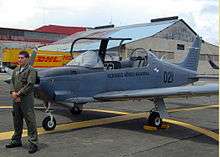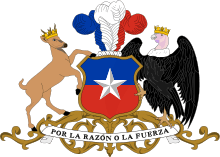Chilean Air Force
The Chilean Air Force (Spanish: Fuerza Aérea de Chile, FACh) is the air force of Chile, a branch of the Chilean military.
| Chilean Air Force | |
|---|---|
| Fuerza Aérea de Chile | |
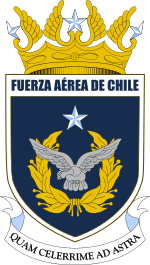 Coat of arms of the Chilean Air Force | |
| Founded | March 21, 1930 |
| Country | |
| Branch | Chilean Armed Forces |
| Type | Air force |
| Role | Aerial warfare |
| Part of | |
| Headquarters | Edificio Delphos Cerrillos, Santiago |
| Motto(s) | "Quam celerrime ad astra" |
| Colors | Indigo White |
| March | Alte Kameraden |
| Anniversaries | March 21 (Air Force Day) |
| Equipment | 180 aircraft/helicopters |
| Engagements | Chilean naval mutiny of 1931 1973 Chilean coup d'état Beagle conflict |
| Commanders | |
| Commander in chief of the Air Force | |
| Notable commanders | Arturo Merino Benítez Marmaduke Grove Gustavo Leigh Fernando Matthei |
| Insignia | |
| Roundel | 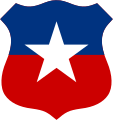  |
| Flag |  |
| Fin flash | |
| Aircraft flown | |
| Electronic warfare | 707 Cóndor AEW&C |
| Fighter | F-16, F-5 |
| Trainer | T-35 Pillán, Super Tucano, T-36 Halcón |
| Transport | C-130 Hercules, UH-1H Huey, Bell 412, UH-60 Black Hawk |
History
The first step towards the current FACh is taken by Teniente Coronel training as a pilot in France. Although a local academy was created, the first officers were sent to France for their training as well. One of them, Captain Manuel Ávalos Prado, took command over the Chilean military aviation school, which was officially established in February 1913, and remained in command until 1915. The Escuela de Aviación Militar (Military Aviation School) was named in honor of him in 1944, and still carries that name today.
In those early years many aviation milestones were achieved; conquering the height of the Andes was one of the main targets as well as long distance flights. Typical aircraft of that era were Avro 504, Bleriot XI, Bristol M.1C, DH.9, and SE5a. In the following decade, the (Airmail Line of Chile) Línea Aeropostal de Chile was created on 5 March 1929 as a branch of the military aviation. This postal airline later developed into the airline Línea Aérea Nacional (National Airline) that is still the leading airline in Chile today. Shortly afterwards, on 21 March 1930, the existing aviation elements of the army and navy were amalgamated into a dedicated department: the Subsecretaria de Aviación (Department of the Air Force) effectively creating the current independent Air Force. It was initially named Fuerza Aérea Nacional (National Air Force). The international airport of Chile carries the name of Lan's founding father and first commander of the air force, Air Commodore Arturo Merino Benítez. Its baptism of fire was in the 1931 sailors' rebellion in Coquimbo, where Air Force attack aircraft and bombers and 2 transport planes converted into bombers contributed to its failure.
The first outlines of the organization of the current air force were visible in 1945 with the inception of Grupo de Transporte No.1 (First Transport Group), later renumbered Grupo 10, with two C-45s and a single T-6 Texan at Los Cerrillos. Two years later the first Fuerza Aérea flight to Antarctica was performed. The fifties meant entry into the jet age for the FACh, and Grupo 7 was the first unit to receive them in 1954. Chile got its aircraft from both the United States and Europe. The American supply consisted of Lockheed F-80, Lockheed T-33, Beech T-34 Mentor, Cessna T-37, Cessna A-37 Dragonfly and Northrop F-5E/F for example, whereas the British supplied Hawker Hunters and the French delivered various helicopters and Dassault Mirage 50 aircraft.
During the military coup d'état on September 11, 1973, the Chilean Air Force bombarded the palace at the request of the Chilean Army.[1]
The Chilean air force hosted the joint exercise Salitre with other friendly nations in 2014.[2] It also participated in several United Nations peacekeeping missions overseas in 5 occasions.
Commanders-in-chief
Order of battle
Personnel = 10,600 (including 700 conscripts)
Office of the Commander in Chief
Combat Command of the Air Force
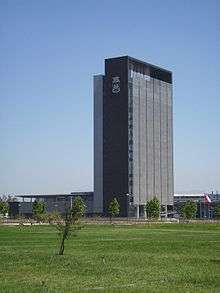
First Air Brigade with headquarters in Los Cóndores Air Base (Base Aérea Los Cóndores) in Iquique
- 1st Aviation Squadron
- 2nd Aviation Squadron
- 3rd Aviation Squadron
- 24th Air Defense Squadron
- 34th Telecommunications Squadron
- 44th Aviation Infantry Squadron
Second Air Brigade with headquarters in Pudahuel Air Base (Base Aérea Pudahuel) in Santiago
- 9th Aviation Squadron
- 10th Aviation Squadron
- Air Defence and Special Forces Regiment (Regimiento de Artillería Antiaérea y FF.EE)
- 32nd Telecommunications Squadron
Third Air Brigade with headquarters in El Tepual Air Base (Base Aérea El Tepual) in Puerto Montt
- 5th Aviation Squadron
- 25th Air Defense Squadron
- 35th Telecommunications Squadron
Fourth Air Brigade with headquarters in Chabunco Air Base (Base Aérea Chabunco) in Punta Arenas
- 6th Aviation Squadron
- 12th Aviation Squadron
- 23rd Air Defense Squadron
- 33rd Telecommunications Squadron
- 19th Antarctic Exploration Squadron
Fifth Air Brigade with headquarters in Cerro Moreno Air Base (Base Aérea Cerro Moreno) in Antofagasta
- 7th Aviation Squadron
- 8th Aviation Squadron
- 21st Air Defense Squadron
- 31st Telecommunications Squadron
- 41st Aviation Infantry Squadron
Personnel Command
Education Division
- Air Force School "Captain Manuel Ávalos Prado"
- Air Force NCO School "Flight Sergeant Adolfo Menadier Rojas"
- Advanced NCO School
- Air War Academy
- Air Force Polytechnical Academy
- Air Photographic Surveying Service
Health Division
General Hospital of the Air Force
Air Force High Command Prefecture
Logistics Command
Maintenance Division
Administration Division
Infrastructure Division
Aircraft
Current inventory
.jpg)
_v2.jpg)
Future Aircraft
The Chilean government has signed letter of intent to purchase six Embraer KC-390 tanker/transport aircraft.[7][8]
Air Defense
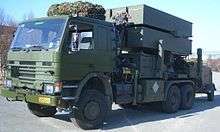
| Name | Origin | Type | In service | Notes | ||
|---|---|---|---|---|---|---|
| SAM | ||||||
| NASAMS | Norway | SAM system | 3[9] | |||
| Sistema Mygale | France | SAM system | 2[9] | |||
| Anti-aircraft artillery | ||||||
| M163 VADS | United States | mobile anti-aircraft gun | 44[9] | weapon is a self-propelled anti-aircraft gun | ||
| M167 Vulcan | United States | towed anti-aircraft gun | 66[9] | |||
| Oerlikon 35 mm twin cannon | Switzerland | towed anti-aircraft gun | 24[9] | |||
Armament

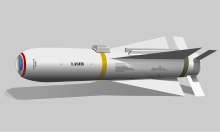

| Name | Origin | Type | Notes | |||
|---|---|---|---|---|---|---|
| Air-to-air missile | ||||||
| AIM-120 C5/C7 AMRAAM[9] | United States | beyond-visual-range missile | initial 100 missiles obtained[9] | |||
| AIM-9 Sidewinder[9] | United States | initial 200 missiles obtained (from 2010 to 2013)[9] | ||||
| RAFAEL Derby | Israel | beyond-visual-range missile | ||||
| RAFAEL Python 4 | Israel | |||||
| Air-to-surface missile | ||||||
| AGM-65 Maverick[9] | United States | |||||
| General-purpose bomb | ||||||
| Mark 84 | United States | |||||
| Mark 82 | United States | |||||
| GBU-12 Paveway II | United States | laser-guided bomb | ||||
| GBU-24 Paveway III | United States | laser-guided bomb | ||||
| Anti-ship missile | ||||||
| AGM-84 Harpoon[9] | United States | |||||
Industry
Chile also maintains its own aviation industry, ENAER. The design of the T-35 Pillán trainer, based on the Piper PA-28 Dakota, is the best known example, seeing some export success as well. Furthermore, the assembly of the A-36/T-36 Halcón (CASA C-101) was achieved as well. Performing maintenance on most types in the current inventory, such as minor modifications on F-5E aircraft for example, the industry is of significant importance to the air force. ENAER is reported to be in talks with Embraer of Brazil to codesign the first indigenous South American military transport plane. Also, under the Pacer Amstel programme, with initial Dutch support, and later locally ENAER upgraded an F-16 combat jet, which for the Chilean Air Force is an advance for their maintenance of the F-16 fleet (becoming the 5th country to modify their jets under authorization).
Ranks
- Officers
| Equivalent NATO code | OF-10 | OF-9 | OF-8 | OF-7 | OF-6 | OF-5 | OF-4 | OF-3 | OF-2 | OF-1 | OF(D) and student officer | |||||||||||||||||||||||||
|---|---|---|---|---|---|---|---|---|---|---|---|---|---|---|---|---|---|---|---|---|---|---|---|---|---|---|---|---|---|---|---|---|---|---|---|---|
(Edit) |
No equivalent |  |
 |
 |
 |
 |
 |
 |
 |
 |
 |
 |
 | |||||||||||||||||||||||
| Air General General de Aire |
Aviation General General de Aviación |
Air Brigade General General de Brigada Aérea |
Commodore Comodoro |
Aviation Colonel Coronel de Aviación |
Group Commander Comandante de Grupo |
Squadron Commander Comandante de Escuadrilla |
Flight Captain Capitán de Bandada |
Lieutenant Teniente |
Sublieutenant Subteniente |
Ensign Alférez |
Officer Cadet Cadete | |||||||||||||||||||||||||
- Enlisted
| Equivalent NATO Code | OR-9 | OR-8 | OR-7 | OR-6 | OR-5 | OR-4 | OR-3 | OR-2 | OR-1 | |||||||||||||||||||||||||||
|---|---|---|---|---|---|---|---|---|---|---|---|---|---|---|---|---|---|---|---|---|---|---|---|---|---|---|---|---|---|---|---|---|---|---|---|---|
(Edit) |
 |
 |
No equivalent |  |
 |
No insignia | ||||||||||||||||||||||||||||||
| Suboficial Mayor | Suboficial | Sargento Primero | Sargento Segundo | Cabo Primero | Cabo Segundo | Cabo | Soldado | |||||||||||||||||||||||||||||
Badges
Officers
| Officer[10] | Line Corps | |||||
|---|---|---|---|---|---|---|
| Badge | ||||||
| Arm of service | Aviation | Engineering | Air Defense | Telecommunications and Information Technology | Administration | Air Base |
| Abbreviation | (A) | (I) | (DA) | (TI) | (AD) | (BA) |
| Specialty | Aviators (Fighter, Helicopter) and Air transport officers | Aviation engineers | Air defense | Information and telecommunications engineers | Engineers assigned to administrative duties | Logistics |
| Officer[10] | Services/Staff Corps | ||||
|---|---|---|---|---|---|
| Badge | |||||
| Arm of service | Justice | Medical Corps Dental Corps | Chaplainancy | Bands Service | General Services Corps |
| Abbreviation | (J) | (S) y (SD) | (SR) | (B) | (SG) |
| Specialty | Attorneys and Judges | Doctors, Nurses and Dentists of various specialties | Chaplains | Musicians | Professional workers and civilian employees |
Non-commissioned officers and airmen
| NCOs and airmen of the[10] | Line Corps | Services Corps | ||
|---|---|---|---|---|
| Badge |  | - | ||
| Arm of service | Weapons | Technical support | Administration | Combat medicine and surgery |
| Specially | Air Defense Intelligence personnel Aircrews | Maintenance and armaments Communications, information technology and electronics Air Operations Support | Administrative staff | Combat medics and surgeons |
Officers' cap badges
Chilean Air Force officers wear the following cap badges in their peaked caps.
| Rank cap badge[11] | Air Generals and Air Commodores | Colonels and Group Commanders | Ensigns through Squadron Commanders | ||||||||
|---|---|---|---|---|---|---|---|---|---|---|---|
| Full dress |  |  |  | ||||||||
| Service dress |  |  |  | ||||||||
| Rank | Air General | Aviation General | Air Brigade General | Air Commodore | Aviation Colonel | Group Commander | Squadron Commander | Flight Captain | Lieutenant | Sublieutenant | Ensign |
In news
The Chilean Air Force reported one of its C-130 Hercules transport aircraft carrying 38 people en route to Antarctica missing on December 9, 2019. The aircraft was on its way to Antarctica’s King George Island to provide logistic support to a military base when radio contact was lost.[12] On 11 December 2019, aircraft debris was located 18 miles South of where the plane last made contact. Chilean authorities will continue to search and hope for a better result however, there is a slim chance of finding survivors at this point. The cause of the crash is unknown and the situation is ongoing.[13]
References
- Notes
- Inquiry into 1973 death of Chile's Salvador Allende Archived 2018-12-25 at the Wayback Machine BBC 2011
- Salitre 2014 Exercise in Chile promotes cooperation among five air forces Archived 2019-03-06 at the Wayback Machine Dialogo Americas 2014
- "World Air Forces 2020". Flightglobal Insight. 2020. Retrieved 10 December 2019.
- "World Air Forces 2011/12". flightglobal insight. Archived from the original on 15 February 2015. Retrieved 16 February 2015.
- "Chilean Air Force Boeing 767". flightglobal.com. Retrieved 10 February 2015.
- "Chilean navy considers Hermes 900". flightglobal.com. Archived from the original on 25 January 2015. Retrieved 10 February 2015.
- "World Air Forces 2015 pg. 13". Flightglobal Insight. 2015. Archived from the original on 24 March 2015. Retrieved 26 December 2014.
- "How Embraer attracted a global audience to the KC-390". flightglobal.com. Archived from the original on 24 April 2015. Retrieved 10 February 2015.
- Trade Registers Archived 2011-01-31 at WebCite. Armstrade.sipri.org. Retrieved on 2015-02-18.
- "Archived copy". Archived from the original on 2010-12-05. Retrieved 2010-10-22.CS1 maint: archived copy as title (link)
- Grados Archived 2010-12-05 at the Wayback Machine
- "Antarctica-bound plane missing with 38 on board". 2019-12-10. Retrieved 2019-12-11.
- Staff; agencies (2019-12-11). "Chilean air force finds debris believed to be from missing plane with 38 people". The Guardian. ISSN 0261-3077. Retrieved 2019-12-12.
External links
| Wikimedia Commons has media related to Fuerza Aérea de Chile. |
- Fuerza Aérea de Chile website (in Spanish)
- Ranks of Fuerza Aérea de Chile website (in Spanish)
